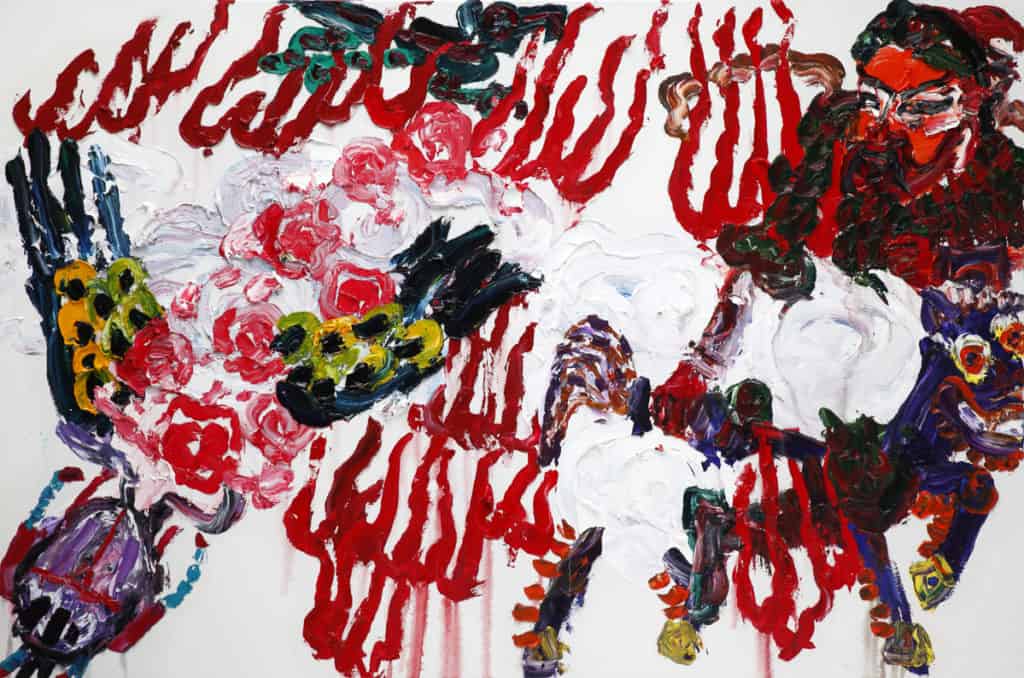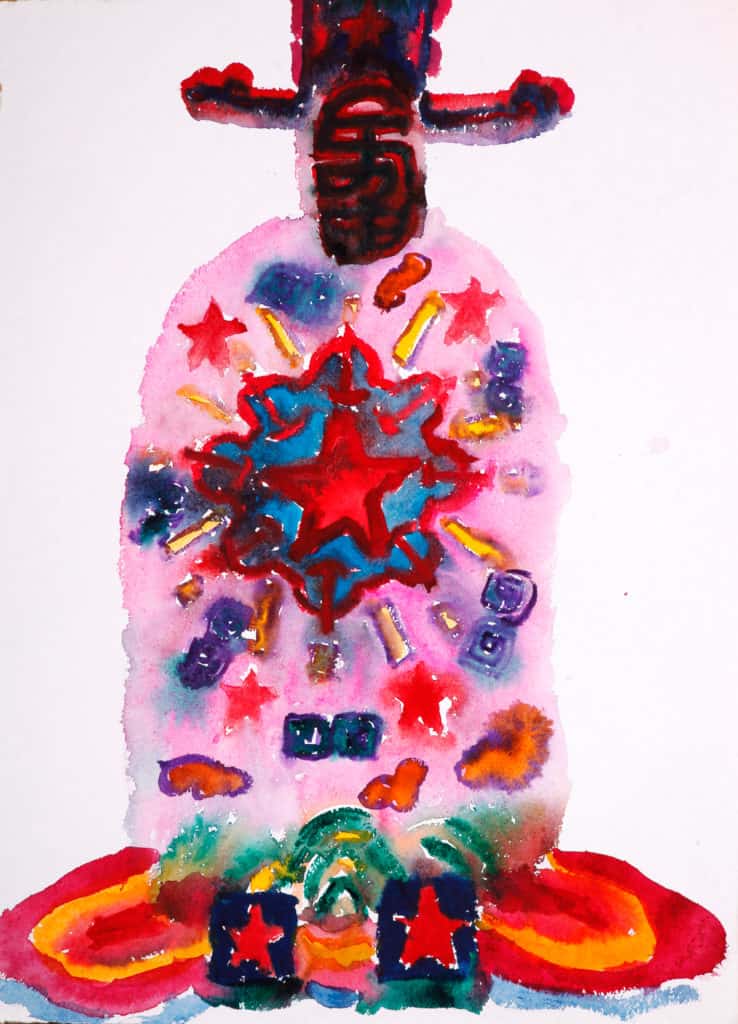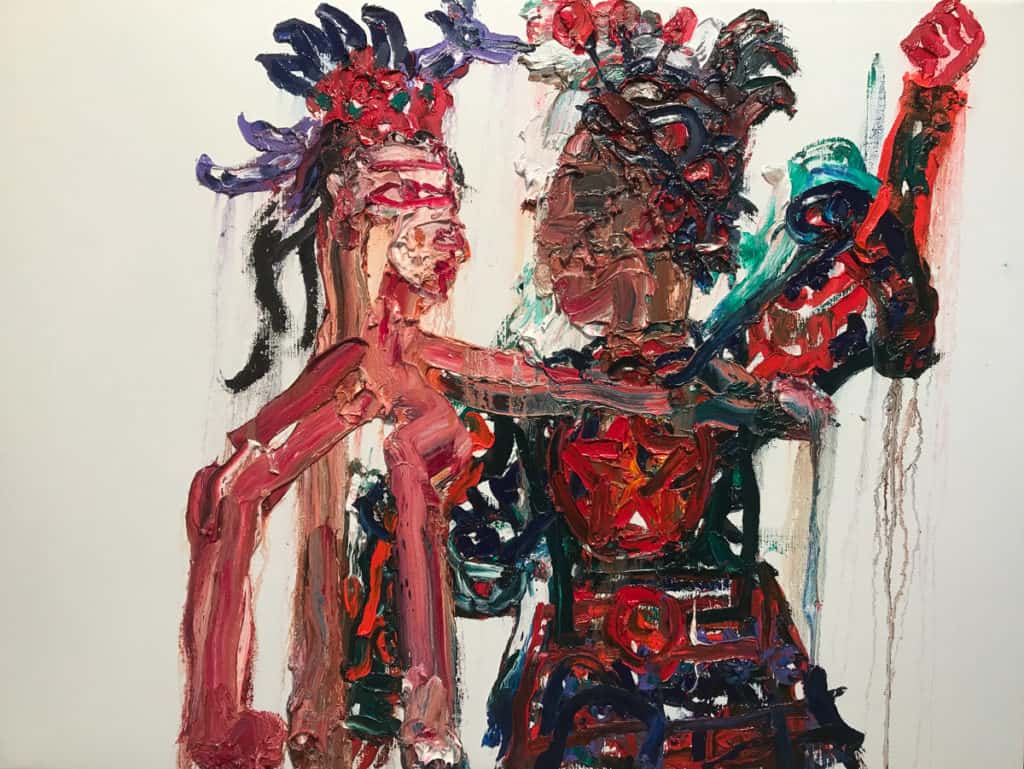- Chen Ping Ladybird’s Garden, 2018, oil on canvas, 122.8 x 182.8 cm
- Chen Ping, Fortune, 2018, watercolour on paper, 76 x 56 cm
- Chen Ping, Emolument, 2018, watercolour on paper, 76 x 56 cm
- Chen Ping Venus vs Hero, 2019, oil on canvas, 92.8 x 122.8 cm
Entering into the Tasmanian Chinese artist Chen Ping’s exhibition Ladybird’s garden I felt like I had entered into a poem. I became the ladybird wandering around, feeding on the colours, decoding the signs and symbols surrounding me. Like a garden there is a fecundity of imagery here, evoking smells and arousing sensual stimuli along with awakening magical beings and hybrid possibilities.
Chen Ping is a storyteller in paint and ink. He enters the world of the imagination, allowing his explorations to collide and meet. Amongst his works, I feel suspended in a mythical world of wandering poets, insects and magical beings floating through a multicultural world of flowers. Ping has gone on a tour of the world looking at flowers, painting these decorative symbols, putting them front and centre in order to question their importance, their link to humanity. They become a common binding thread through our cultural differences.
Threads of Chinese heritage are wound through Tasmania since the early days of tin mining in the 1880s. The workers were highly respected and gradually integrated into Tasmanian businesses and community. Traces of statues and imagery are embedded in unusual places in the Tasmanian landscapes and Ping builds on encounters with these surreal forms in gardens and wild areas that are reclaiming abandoned mine sites. Ping’s enthusiasm for cross-cultural dialogue has assisted in the formation of a Tasmanian Centre for Chinese Art in Tasmania that will involve exhibitions and exchanges.
Through the imagery of flowers, Ping is querying why these forms are pervasive in all cultures and in all periods of art production. What is it about the floral form that binds us as humans? How does this common language reveal a common humanity and yet we are prepared to kill for perceived transgressions?
In his paintings, his marks and gestures are tracing the structures and formal decisions made by artists across cultures and time. Through the language of paint, Ping seeks understanding of how patterns are formed and how they arrive at meaning. Within these works, we can find Eastern, Islamic and Western depictions of flowers. By tracing their forms with his particular brush stroke, Ping arrives at understanding but also new associations, links and references.
In examining flowers from his Chinese heritage Ping said that as he was painting the forms, he wondered at their amazing link to Van Gogh. On further research, he discovered that Van Gogh in his early work had been copying forms from Chinese woodblocks. Ping realised that the marks of Van Gogh are arrived at through process, rather than the disturbance of the mind as Art History would have us believe.
This ladybird’s garden of flowers is inhabited by the many magical, fabulist beings that haunt our imagination reminding us of the extremes of human behaviour, the moments of great achievements, the invention of fire, the transformation of materials, from minerals into metals, into wheels, into carriages that sweep us through this world. The wars, the terrors, the transgressions, the constant tensions and divisions in the world that continue over millennia. These forms are not representational, they are not diagrammatic or illusionistic. Ping has brought his knowledge of paint, its fluidity, its structural material presence into dialogue with the traditions of Chinese calligraphy and ink and wash painting.
These works build on the traditions of the Chinese literati where poem and painting were part of the whole work. The mark of both text and image reveal the artist’s literacy and training, the skill level achieved, the influences of previous scholars but also the weaknesses in the turn of the wrist, the gaps in knowledge, the tweaks of ego.
The painted mark in this tradition has as its core principle a suspension between what we consider the “real” and the “not real”. The mark is made in the real world, it is about the natural world, informed by observation but also by imagination. It is a real mark. When it is made it reflects that moment of creation: everything in the world, the temperature, the smells of the bakery nearby, the sputtering car, the wings of a ladybird all conspire to influence that mark.
In Ping’s luscious marks, it is if we are suspended in that moment of creation. The works are so fresh that the figures and stories are held, poised in the moment of becoming. The narrative is held in the fluidity of paint. The paint is not attempting to be anything other than paint. The marks all link and join if you follow the trail of the hand and the back and forth overlays of the artist as he negotiates the story and the language and logic of paint.
Why create such a world of otherness in the contemporary moment? Why flowers. Why the decorative? And yet aren’t they common to all cultures to all humanity? It is a common theme in all our hearts: flowers and garden are depicted in all art forms, across time, place, cultures. They reveal our similar hopes and desires, similar fears and dreams, the eternal struggles of life continue.
Ping maintains the Chinese tradition of calligraphic mark making that they brought into landscape painting. The marks oscillate between line and colour. Paint itself is ambiguous and occupies different spaces and different times. Is it foreground, is it blob or petal, foot or fire? The ability of paint to be so many things at once, allows this multicultural exploration to be possible. Ping brings us into this world of ritual and process, the good and bad that exist in the world, but makes no judgements, inviting us into the uneasy path that we need to negotiate the multiplicity, the collisions of so many possibilities in the contemporary world.
Author
 Jan Hogan is an artist and academic specialising in notions of place, interweaving material traces with memory through the processes of making and writing. Jan is currently Head of the Art School, University of Tasmania. Her exhibition of prints and artists books at Craft ACT opened on 16 May 2019.
Jan Hogan is an artist and academic specialising in notions of place, interweaving material traces with memory through the processes of making and writing. Jan is currently Head of the Art School, University of Tasmania. Her exhibition of prints and artists books at Craft ACT opened on 16 May 2019.





